What is NikCLI?
NikCLI is a revolutionary autonomous AI development assistant that transforms how you approach software development. It combines the power of advanced AI models with deep project understanding to provide intelligent, context-aware assistance for your development workflow.Autonomous Development
AI agents that can work independently on complex development tasks
Context Awareness
Deep understanding of your project structure, patterns, and conventions
Multi-Agent System
Specialized agents working together for optimal results
Natural Language
Communicate with AI using natural language, just like with a human developer
Core Interaction Modes
NikCLI offers three primary modes of interaction, each optimized for different development scenarios:1. Chat Mode (Default)
Interactive conversational development with real-time feedback.- Learning and experimentation
- Step-by-step development
- Code review and debugging
- Quick modifications
2. Autonomous Mode
AI works independently on complex tasks with minimal supervision.- Large feature implementations
- Repetitive tasks
- Boilerplate generation
- System-wide refactoring
3. Planning Mode
Collaborative planning and review before implementation.- Complex feature planning
- Architecture decisions
- Team collaboration
- Learning AI’s approach
Key Features and Capabilities
Intelligent Project Understanding
NikCLI automatically analyzes your project to understand:Technology Stack Detection
Technology Stack Detection
- Frameworks: React, Vue, Angular, Express, Fastify, etc.
- Languages: TypeScript, JavaScript, Python, Go, etc.
- Tools: Webpack, Vite, ESLint, Prettier, etc.
- Databases: MongoDB, PostgreSQL, MySQL, SQLite, etc.
Code Patterns and Conventions
Code Patterns and Conventions
- Component structure and naming conventions
- State management patterns (Redux, Zustand, Context)
- API design patterns (REST, GraphQL)
- Testing approaches and frameworks
Project Architecture
Project Architecture
- Folder organization and structure
- Module boundaries and dependencies
- Configuration files and settings
- Build and deployment pipelines
Advanced Code Generation
NikCLI generates production-ready code that follows your project’s patterns:- React Components
- API Endpoints
- Database Models
Multi-Agent Orchestration
Different specialized agents work together on complex tasks:Workflow Patterns
Feature Development Workflow
1
Requirements Analysis
2
Architecture Planning
3
Implementation
NikCLI implements each component while maintaining consistency across the stack.
4
Testing & Validation
5
Documentation & Cleanup
NikCLI updates documentation and ensures code quality.
Bug Fix Workflow
1
Issue Analysis
2
Root Cause Identification
3
Fix Implementation
NikCLI implements the fix while ensuring no regression.
4
Testing
NikCLI runs tests and may add new test cases to prevent regression.
Refactoring Workflow
1
Code Analysis
2
Impact Assessment
NikCLI analyzes all files that would be affected by the refactoring.
3
Gradual Migration
NikCLI implements changes incrementally to maintain functionality.
4
Validation
All tests pass and functionality is preserved.
Best Practices
Effective Communication
Be Specific
Good: “Create a React hook for managing form state with validation for email and password fields”Better: “Create a useForm hook that validates email format and password strength, with real-time feedback”
Provide Context
Good: “Add authentication”Better: “Add JWT-based authentication to our Express API, compatible with our existing user model”
Reference Existing Code
Example: “Create a component similar to UserCard.tsx but for displaying product information”
Specify Constraints
Example: “Implement this feature without adding new dependencies to package.json”
Code Quality Guidelines
Follow Project Conventions
Follow Project Conventions
NikCLI automatically adapts to your project’s patterns, but you can explicitly request adherence:
Request Code Reviews
Request Code Reviews
Ensure Test Coverage
Ensure Test Coverage
Security Considerations
NikCLI includes built-in security policies and best practices:Safe Command Execution
- Restricted command allowlist
- Path-based access controls
- Approval required for sensitive operations
Code Security
- Input validation and sanitization
- SQL injection prevention
- XSS protection in generated code
API Security
- Secure API key storage
- Token-based authentication
- Rate limiting implementation
File System Safety
- Restricted file access
- Backup creation for critical files
- Version control integration
Common Use Cases
Development Scenarios
- New Feature
- Code Optimization
- Bug Investigation
- Integration
- Creates database models
- Implements API endpoints
- Builds frontend components
- Adds routing and navigation
- Includes comprehensive testing
Performance and Efficiency
Token Management
NikCLI automatically manages AI model token usage:- Context Compression: Intelligently summarizes conversation history
- Relevant Context: Only includes pertinent project information
- Caching: Reuses analysis results for similar requests
- Streaming: Real-time response generation for faster interaction
